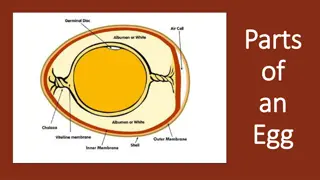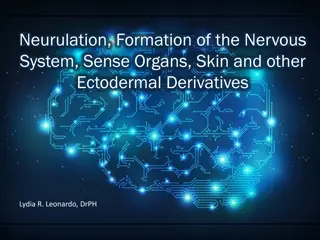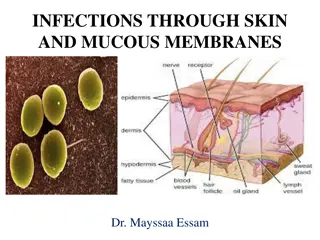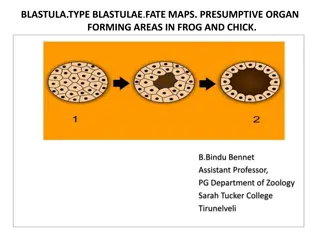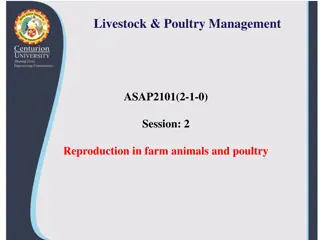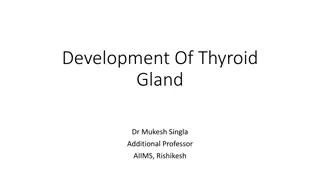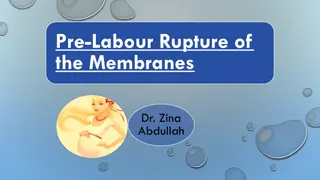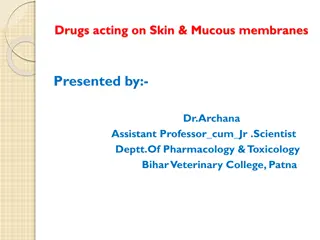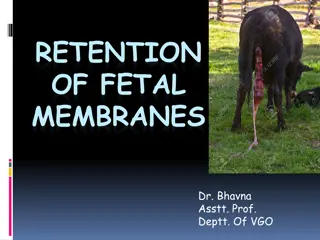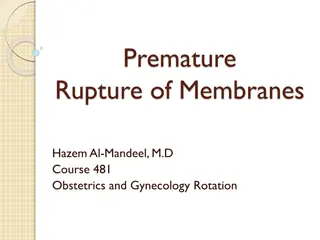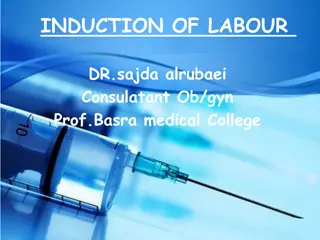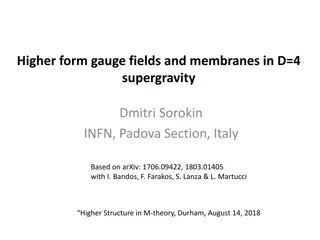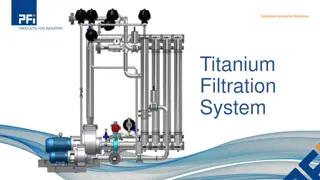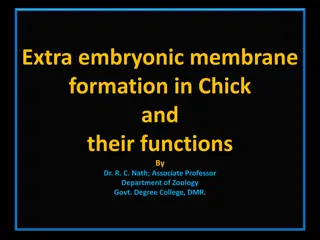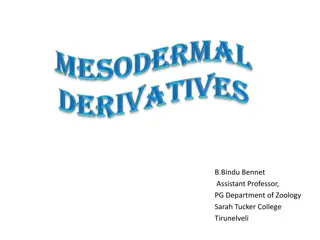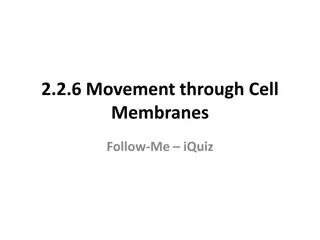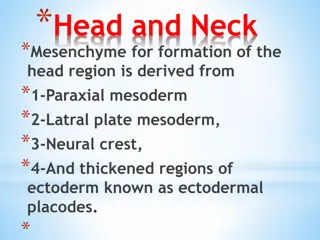Understanding Lipids: Properties, Functions, and Types
Lipids are a diverse group of organic compounds that include fats, oils, hormones, and components of cell membranes. They are vital for energy storage, structural roles in cell membranes, hormone synthesis, and organ protection. Lipids can be classified into different types such as waxes, triglyceri
11 views • 14 slides
Transgenic Animal Production
Transgenic animal production involves deliberate genetic modifications for improved traits. Methods like electroporation, lipofection, microinjection, and embryonic stem cell transfer are used. Benefits and drawbacks are discussed in detail.
2 views • 16 slides
An In-Depth Look at the Parts of an Egg
Explore the various components that make up an egg, from the protective shell to the germinal disk containing genetic material. Learn about the roles of the membranes, albumen, yolk, chalaza, and more in this informative visual guide. Follow along with descriptions and images to deepen your understa
1 views • 11 slides
Embryonic Development: Key Processes and Organization
Embryonic development involves neurulation, organogenesis, and morphogenetic processes that shape the nervous system, sense organs, skin, and other ectodermal derivatives. The embryo undergoes allocation and differentiation processes, influenced by epigenetic events and the action of organizers. Emb
2 views • 25 slides
Understanding Infections through Skin and Mucous Membranes
Infections can be transmitted through skin and mucous membranes via direct or indirect human contact, as well as from non-human sources. The infective agents include viruses, bacteria, fungi, and arthropods. Factors like high population density, poor hygiene, and host behavior play crucial roles in
4 views • 26 slides
Types of Blastulae and Their Formation in Frog and Chick Embryos
The development of blastula, an important stage in embryonic development, gives rise to various types such as coeloblastula, discoblastula, and blastocyst in different animal species. In frogs and birds, varied forms of blastulae are observed based on the amount of yolk present, leading to distinct
1 views • 21 slides
Development of Human Face and Oral Cavity in Embryology
The process of embryonic development involves the formation of the human face and oral cavity from the morula stage onwards. Key structures such as the primitive streak play a vital role in establishing bilateral symmetry, initiating germ layer formation, and guiding gastrulation. The differentiatio
2 views • 32 slides
Comprehensive Overview of Treatment Membranes in Water Quality Risk Assessment Training
Comprehensive overview of treatment membranes in water quality risk assessment training, covering various membrane types, applications, and considerations. Membranes play a crucial role in removing a range of contaminants from water sources, with different membrane types suited for specific applicat
0 views • 9 slides
Mechanism of General Anaesthesia Theories: Lipid Solubility, Surface Tension, Microcrystal, Protein Binding
Mechanism of general anaesthesia involves theories focusing on the interaction of anaesthetics with cell membrane components like lipids and proteins. The Lipid Solubility theory emphasizes the importance of an anaesthetic's affinity and solubility in nerve cell membranes, while the Surface Tension
1 views • 10 slides
Understanding the Gibbs-Donnan Effect in Biological Systems
The Gibbs-Donnan Effect, named after physicists Gibbs and Donnan, explains the selective permeability of membranes to ions, leading to the establishment of Donnan potential. This phenomenon affects the distribution of ions and proteins across cell membranes, influencing processes like osmosis and io
0 views • 27 slides
Professional Video Filming Services by Extra Media Production
Extra Media Production is a company specializing in professional and promotional video filming services. Their team of young and vibrant professionals offers a range of expertise including producers, directors, camera operators, editors, lighting technicians, sound operators, script writers, and adv
0 views • 11 slides
Wiltshire Extra Care Housing Resident Co-production Session
Welcome to the Wiltshire Extra Care Housing Resident Co-production Session where the focus is on discussing a new support model for extra care. The session includes introductions, presentations, breakout groups for sharing ideas, and receiving feedback on the proposed approach to co-production. Join
1 views • 23 slides
Understanding Reproduction in Livestock and Poultry Management
This course delves into the intricate processes of reproduction in farm animals and poultry, covering stages like proestrus, estrus, metestrus, diestrus, and anestrus. It explores the roles of hormones like testosterone, estrogen, progesterone, relaxin, and oxytocin in regulating reproductive functi
0 views • 51 slides
Basics of Fingerprinting: Biological Formation of Ridges
Fingerprints are formed due to the proliferation of cells in the epidermis, resulting in ridges and patterns unique to each individual. The process begins in the embryonic stage with the development of volar pads on fingertips, palms, and soles. As the skin matures, primary and secondary ridges are
0 views • 11 slides
Development of Thyroid Gland in Embryonic Stage
The thyroid gland is the first endocrine gland to develop in the human body, starting from a median endodermal thickening in the primitive pharynx. The process involves the descent of the thyroid diverticulum and formation of lobes by week 7 of embryonic development. The thyroid gland begins functio
0 views • 24 slides
Understanding Stem Cells and Their Applications
Stem cells are unique cells that have the potential to develop into various types of cells in the body. They play a crucial role in renewing and repairing tissues, offering hope for treating various medical conditions. While adult stem cells can differentiate into limited cell types, embryonic stem
0 views • 9 slides
Clinical Diagnosis and Assessment of Pre-Labour Rupture of the Membranes
Pre-Labour Rupture of the Membranes (RROM) is characterized by the leakage of amniotic fluid before the onset of labor, particularly when the gestational age is less than 37 weeks. Clinical diagnosis involves a thorough history evaluation and examination, including sterile speculum examination to co
0 views • 18 slides
Overview of Drugs Acting on Skin & Mucous Membranes
This presentation discusses different classes of drugs that act on the skin and mucous membranes, including emollients, demulcents, adsorbents, protectives, astringents, counterirritants, keratolytics, and skin disinfectants. Emollients soften and moisturize the skin, demulcents soothe irritation in
3 views • 10 slides
Understanding Retention of Fetal Membranes in Veterinary Obstetrics
Retention of fetal membranes, a common issue during the third stage of labor, has significant consequences for animals, especially cattle. Causes include insufficient expulsive efforts and placental issues. The incidence ranges from 6.8% to 50%, often associated with dystocia and twin births. Factor
0 views • 25 slides
Premature Rupture of Membranes: Diagnosis and Management Overview
Premature rupture of membranes (PROM) is a complication in pregnancy where the amniotic sac breaks before labor begins. Risk factors include infections and multiple gestations. Diagnosis involves history, physical examinations, and tests like nitrazine and ferning tests. Management depends on gestat
0 views • 7 slides
Overview of Induction of Labour for Obstetric Practice
Induction of labor is the artificial initiation of the labor process before it begins naturally. This procedure is performed in cases such as premature rupture of membranes, prolonged pregnancy, preterm premature rupture of membranes, pre-eclampsia, and maternal medical conditions like diabetes or c
1 views • 30 slides
Engineering a Hydrophilic Coating for Water Filtration Membranes
Explore the process of designing a model with hydrophilic polymers as antifouling coatings for water filtration membranes. Discover how these coatings resist fouling, ensuring clean water for consumption.
1 views • 12 slides
Higher-Form Gauge Fields and Membranes in D=4 Supergravity
This study focuses on higher-form gauge fields and membranes in D=4 supergravity, exploring their role in cosmological constant generation and membrane nucleation. The dynamics of three-form gauge fields, their coupling to gravity and membranes, and implications for cosmological models and supersymm
0 views • 17 slides
Titanium Filtration System Overview
A comprehensive overview of the Titanium Filtration System, highlighting its unique titanium membrane technology, benefits over traditional membranes, and comparison with traditional membranes in terms of temperature resistance, chemical and erosion resistance, service life, and more. The system fea
0 views • 10 slides
Important Class Updates and Extra Credit Opportunities
Quiz on Thursday with extra credit questions, Diary Study due today, and Extra Credit R-Points for experiments available. Review questions on family values and homeostasis in families. Class discussion on illness and stigma, reactions to stigmatized individuals, and marked and markers in stigmatized
0 views • 24 slides
Understanding Membrane Transport Processes in Plant Cells
Plant cells are separated from the environment by plasma membranes, which facilitate the movement of molecules through passive and active transport mechanisms. Transport proteins play a crucial role in allowing the movement of ions and polar molecules, with channels, carriers, and pumps enhancing so
0 views • 20 slides
Extra Embryonic Membrane Formation in Chick and Their Functions
The development of extra embryonic membranes in chick embryos plays a crucial role in their growth and protection. These membranes, including the amnion and chorion, serve various functions such as providing protection, facilitating gas exchange, and supporting the formation of the placenta. Underst
0 views • 20 slides
Understanding Active Transport of Molecules: Driven by ATP Hydrolysis
Active transport, fueled by ATP hydrolysis, facilitates the movement of molecules against their concentration gradients, essential for processes like ion pumping across membranes. The Na+-K+ pump, a prime example, utilizes ATP to transport Na+ and K+ ions across cellular membranes, maintaining impor
0 views • 23 slides
Development of Extraembryonic Membranes in Frog Embryos
The developmental stages of extraembryonic membranes in frog embryos are visually illustrated in a series of images. These images showcase the intricate processes involved in the formation of structures such as the amnion, chorion, yolk sac, and allantois, leading up to the development of the placen
0 views • 18 slides
Understanding the Structure and Function of Cell Membranes in Biology
Explore the intricate details of cell membranes, focusing on the phospholipid bilayer structure, protein interactions, selective permeability, and various transport mechanisms. Discover how membranes regulate the entry and exit of substances, aid in metabolism, and compartmentalize organelles for ef
0 views • 20 slides
Understanding Osmosis in Cell Membranes
This quiz explores the concept of osmosis in cell membranes, focusing on the movement of water into outermost cells of roots by osmosis and its implications on cell sap. It covers topics such as active transport, diffusion, pressure in cell contents, and the role of water movement in maintaining the
0 views • 50 slides
Understanding Biomembranes: Composition, Structure, and Functions
Biomembranes, specifically the plasma membrane, play a crucial role in cell function by separating and protecting the cell, facilitating communication with the environment, and regulating transport processes. Composed of lipids, proteins, and carbohydrates, membranes have a fluid mosaic structure wi
0 views • 13 slides
Investing in Extra Care in Manchester: A Cost Benefit Analysis
Devolution and new investment in Health & Social Care in Manchester led to the use of Cost Benefit Analysis (CBA) to secure funding for Extra Care services. By presenting business cases supported by CBA, Manchester secured funding for innovative care models, including Extra Care, improving access to
0 views • 12 slides
Development of Maxillary Prominences and Secondary Palate in Embryonic Development
New outgrowths from the medial edges of the maxillary prominences form the shelves of the secondary palate. Fusion of these palatal shelves involves complex cellular changes, such as elevation after the withdrawal of the tongue and alterations in epithelium leading to adhesion and fusion. The fate o
0 views • 23 slides
Understanding Stem Cells and Cell Potency in Animal Cells
Stem cells play a crucial role in animal cells, offering the potential to differentiate into various cell types. Totipotent stem cells are the most versatile, capable of developing into any cell type in the embryo, including extra-embryonic cells. Pluripotent stem cells can give rise to all body cel
0 views • 22 slides
Development of Fetal Head and Neck Structures in Week 12
The fetal head and neck structures in week 12 exhibit a complex formation process involving contributions from all three embryonic layers and the neural crest. Neural crest plays a significant role in developing jaw skeletal elements, connective tissues, and tendons. The pharynx, starting at the buc
0 views • 30 slides
Development of Head and Neck Mesenchyme in Embryonic Formation
The formation of the head and neck region in embryonic development involves mesenchyme derived from paraxial mesoderm, lateral plate mesoderm, neural crest, and ectodermal placodes. Paraxial mesoderm contributes to brain case and muscle formation, while lateral plate mesoderm forms laryngeal cartila
0 views • 34 slides
Products for "Full Automatic Blood Pressure W/extra Large Cuff & 4 Aa Batt
The Full Automatic Blood Pressure Monitor with Extra-Large Cuff is designed for users with larger arms, fitting arm circumferences from 12.6 to 20.5 inches. It includes an extra-large cuff, 4 AA batteries, and a bonus travel pouch for convenience.\n\
11 views • 8 slides
Two-Dimensional Mathematical Model of Flows in Thin Film Composite Membranes
This study presents a mathematical model for flows in thin film composite membranes, focusing on the permeation of solvent flux and solute rejection. Assumptions include incompressible fluid, constant diffusion of chemical species, and isothermal conditions. Equations describe water flux, solute flu
0 views • 19 slides
Understanding Sterilization and Disinfection Methods
Sterilization involves killing all microorganisms, including bacterial spores, using physical, chemical, and mechanical methods. Disinfection, on the other hand, focuses on removing microorganisms using disinfectants. Chemical methods like antiseptics and disinfectants play a crucial role in ensurin
0 views • 18 slides


